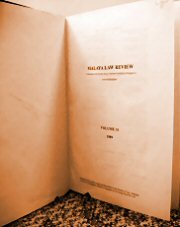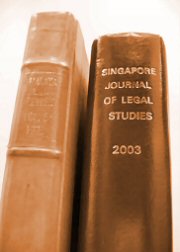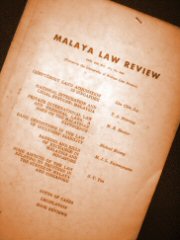|
Archive |
2386 records match your query:
| 501. | DECEMBER 2006 Issue | p.524 | |
| | Book Review: Transition Politics in Southeast Asia: Dynamics of Leadership, Change and Succession in Indonesia and Malaysia by Yang Razali Kassim
Tey, Hsun Hang • [2006] Sing JLS 524 (Dec)
| | 502. | DECEMBER 2006 Issue | p.524 | |
| | Book Review: Era of Transition: Malaysia after Mahathir by Ooi Kee Beng
Tey, Hsun Hang • [2006] Sing JLS 524 (Dec)
| | 503. | JULY 2006 Issue | p.1 | |
| | Of Precedent, Theory and Practice - The Case for a Return to Anns
Phang, Andrew, Saw, Cheng Lim, ad Chan, Gary • [2006] Sing JLS 1 (Jul)The English position with respect to duty of care in the context of recovery for pure economic loss is clear and is firmly set against recovery, as stated in the leading decision of the House of Lords in Murphy v. Brentwood District Council. The decisions of the House have long had an important-even decisive-impact on the common law landscape across the Commonwealth. However, this is one of the rare situations where there have been departures in the Commonwealth from the established English position. These departures have, nevertheless, been by no means uniform.Yet, one common theme that unifies these approaches is the commitment to the former English position as embodied in the propositions laid down by LordWilberforce in the House of Lords decision in Anns v. Merton London Borough Council. The Anns approach has, however, been rejected in England. This paper therefore seeks to demonstrate that the propositions laid down by Lord Wilberforce in Anns were entirely correct and workable and that all the subsequent formulations (in the main, those emanating from the House of Lords) effectively-and simply-restate the Anns formulation.
[Full Text]
| | 504. | JULY 2006 Issue | p.60 | |
| | Regulating Supreme Court Recusals
Olowofoyeku, Abimbola A • [2006] Sing JLS 60 (Jul)This article presents a critical analysis of the approach of the U.S. Supreme Court to recusal motions aimed at one of the Justices of the Court. The catalyst was the controversy arising from the weekend duck-hunting trip of U.S.Vice-President Richard Cheney and Supreme Court Justice Antonin Scalia, after which Justice Scalia denied a motion to recuse himself from a pending case in which his hunting partner, Mr Cheney, was a party. This startling decision is final and conclusive since the Supreme Court refuses to intervene in such decisions. Such an approach by the Court is untenable and contrasts starkly with that of the House of Lords, which did not shrink from disqualifying Lord Hoffmann on grounds of bias in the Pinochet case. A comparative study of comparable common law jurisdictions exposes the U.S. Supreme Court as an island of isolation over this issue. It also provides accessible solutions that are disarming in their simplicity. The particular responses that are commended in this article are formalized self-regulation and substitution.
[Full Text]
| | 505. | JULY 2006 Issue | p.86 | |
| | Causation and Breach of Fiduciary Duty
Vann, Vicky • [2006] Sing JLS 86 (Jul)Two recent English decisions have highlighted the issue of causation in the context of breach of fiduciary duty. In both cases, the defendant implicitly argued that whether the profits or conflicts rule is breached, the causation standard is the same. This article suggests that the causation standards applicable for the profits and conflicts rules are different. When equitable compensation is sought for loss due to breach of the conflicts rule, there must be a causal connection between the conflict and the loss. But there is no special causation standard applicable when an account of profits is sought following a breach of the profits rule. Any unauthorised profit made within the scope of the relationship attracting fiduciary duties must be accounted for. These standards are appropriate in the context of the rules breached, because they best achieve approximation of loyal performance of the duties owed.
| | 506. | JULY 2006 Issue | p.108 | |
| | Unburdening the Constitution: What has the Indian Constitution got to do with Private Universities, Modernity and Nation-States?
Dam, Shubhankar • [2006] Sing JLS 108 (Jul)This article critically analyses the decision of the Indian Supreme Court in Yashpal and another v. State of Chhattisgarh and others holding the establishment of private universities as unconstitutional. Swayed by the overwhelmingly irresponsible character of the respondent universities, the Supreme Court innovated constitutional arguments to uphold the claims of the petitioners. While intuitively correct in the context of the immediate facts, the judgment, when analysed in the abstract, reveals the self-inflicted harm it has the potential to cause. The judgment is technologically regressive: it fails to account for the emerging trends in education, especially those related to the use of technology and in particular about the emergence of e-education. It is also unconstitutional: it purports to add grounds for judicial review of primary legislation that agreeably is a constituent rather than an adjudicative act. Finally, it is backward looking: it proposes to reintroduce a moralizing rhetoric in the conduct of education, thereby, paving way for poorer educational standards in India. Underlying these distinct inadequacies is a common inability of the Supreme Court to de-link the university as a "project of modernity" from its status as "the ideological apparatus of the nation-state." Universities, for the Indian Supreme Court, are still an embodiment of the "popular will" and, therefore, incapable of being appropriated.
| | 507. | JULY 2006 Issue | p.148 | |
| | The Doctrine of Informed Consent - When Experts and Non-Experts Collide
Tan, Paul • [2006] Sing JLS 148 (Jul)It will not be long before the Singapore Court of Appeal will have to confront the question it left open in Gunapathy and decide whether it should extend the Bolam principle to negligent advice cases as the House of Lords has done, or whether it should follow the more rigorous standard applied in other jurisdictions such as Canada and Australia. Rather than focus on the narrow and intractable debate about the philosophical values underlying both approaches (patient autonomy versus medical paternalism), this article draws on current behavioural and psychological studies to examine which approach would truly assist a patient in arriving at a rational and informed choice. It is argued that neither model currently employed is satisfactory because they fail to take into account the fact that the patient, as a layperson, and the physician, as an expert, perceive risk differently. Accordingly, it is proposed that the doctrine of informed consent should be structured to emphasize the constitutive nature of risk communication in order to bridge this difference.
| | 508. | JULY 2006 Issue | p.172 | |
| | The Competition Act 2004: A Legislative Landmark on Singapore's Legal Landscape
Ong, Burton • [2006] Sing JLS 172 (Jul)
| | 509. | JULY 2006 Issue | p.191 | |
| | Equitable Relief for Breach of Contract: Wisanggeni Lauw v Full Fledge Holdings Ltd
Tham, Chee Ho • [2006] Sing JLS 191 (Jul)
| | 510. | JULY 2006 Issue | p.200 | |
| | Charge Characterisation in English Law: A Settled Debate? In Re Spectrum Plus Ltd
Turner, PG • [2006] Sing JLS 200 (Jul)
| |
|
|


 |







